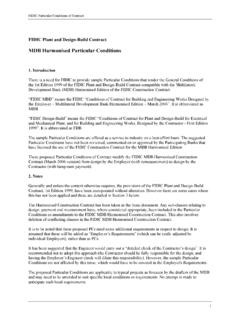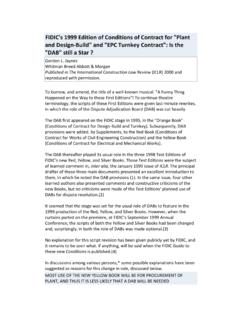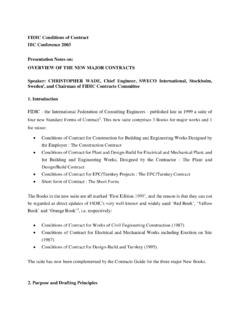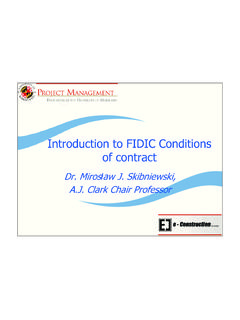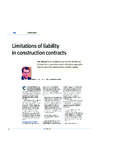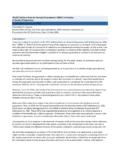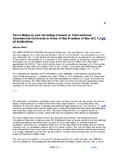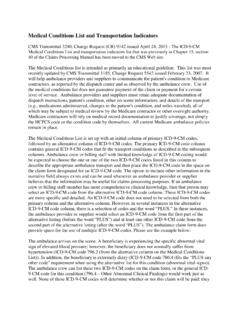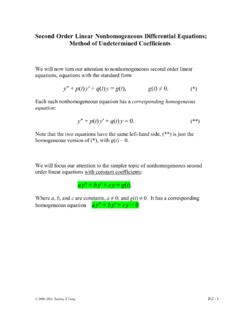Transcription of FIDIC Conditions of Contract
1 FIDIC Conditions of Contract IBC Conference 2003 Presentation Notes on: OVERVIEW OF THE NEW MAJOR CONTRACTS Speaker: CHRISTOPHER WADE, Chief Engineer, SWECO International, Stockholm, Swedenl, and Chairman of FIDIC Contracts Committee 1. Introduction FIDIC - the International Federation of Consulting Engineers - published late in 1999 a suite of four new Standard Forms of Contract2. This new suite comprises 3 Books for major works and 1 for minor: Conditions of Contract for Construction for Building and Engineering Works Designed by the Employer : The Construction Contract Conditions of Contract for Plant and Design-Build for Electrical and Mechanical Plant, and for Building and Engineering Works, Designed by the Contractor : The Plant and Design/Build Contract Conditions of Contract for EPC/Turnkey Projects : The EPC/Turnkey Contract Short form of Contract : The Short Form.
2 The Books in the new suite are all marked First Edition 1999 , and the reason is that they can not be regarded as direct updates of FIDIC 's very well-known and widely used Red Book , Yellow Book and Orange Book 3, respectively: Conditions of Contract for Works of Civil Engineering Construction (1987) Conditions of Contract for Electrical and Mechanical Works including Erection on Site (1987) Conditions of Contract for Design-Build and Turnkey (1995). The suite has now been complemented by the Contracts Guide for the three major New Books. 2. Purpose and Drafting Principles When drafting these new standard Conditions , the following principles were followed: for engineering construction contracts, between `the Employer' and `the Contractor' primarily for international projects (adjustment for national projects possible) manuals of good engineering practice prepared by engineers for practical use balance between legal precision and practicability, correct level of detail to cover projects of all sizes and complexity to be equitable to employer and contractor (any imbalance of risks to be clearly stated) provide flexibility for individual contracts 2 parts - General Conditions and Particular Conditions 3.
3 Standardisation and User Friendliness The old Books were not standardised. The New Books should be standardised as far as possible and as user friendly as possible. The `users' will be those preparing documents for a project, and those using them during construction. definitions and terminology are the same in all 3 Books (except for intentional differences) 20 Clause layout and titles are the same (except for intentional differences) wording identical (except for intentional differences) diagrams of typical sequence of events included alphabetical list of definitions clauses included applicable to most (but not all) contracts alternative clauses in Guidance for Preparation of Particular Conditions clauses often interchangeable, import from another Book data required by General Conditions included in Appendix to Tender (EPCT Part.)
4 Conds) simple to delete or not invoke clauses which are not required forms for guarantees, Letter of Tender, Contract and DAB Agreements, etc, included index of Sub-Clauses included But remember: preparation to be done by experienced personnel - not `blind' acceptance! clauses must always be checked for appropriateness, and adjusted where necessary adjustments/modifications to be made in Particular Conditions use Guidance for Preparation of Particular Conditions 4. Conditions of Contract for Construction for Building and Engineering Works Designed by the Employer The New Red Book is similar to - and an update of - the Old Red Book, but with new features: Old Red Book dealt only with civil construction work - the New Red Book covers all types of work designed by the Employer. suitable for all projects where main responsibility for design lies with Employer (or his Engineer) some design may, of course, be carried out by Contractor basically an update of Old Red Book administration of Contract and supervision by Engineer approval of work, payment, etc.
5 Certified by Engineer work done is measured, payment according to Bill of Quantities option for payment on Lump Sum basis 5. Conditions of Contract for Plant and Design-Build for Electrical and Mechanical Plant, and for Building and Engineering Works, Designed by Contractor The New Yellow Book replaces both the Old Yellow Book and the Orange Book: Old `Yellow Book' dealt only with electrical and mechanical construction works (most design being done by Contractor) the Orange Book from 1995 dealt with Design-Build and Turnkey for civil and other construction where majority of design done by Contractor the New Yellow Book covers all types of work designed by the Contractor it therefore updates and replaces both the Old Yellow and the Orange Books (layout of all the New Books follows closely that of the Orange Book) New Yellow Book is thus suitable for all types of projects where main responsibility for design lies with Contractor recommended for the provision of electrical and/or mechanical plant, and for the design and execution of building or engineering works (the majority of such projects may well be electrical and mechanical works.)
6 Many will be a combination of civil, e & m, and/or building) some design may, of course, be carried out by Employer or his Engineer Employer provides `Employer's Requirements' to which Contractor designs administration of Contract and supervision by Engineer approval of work, payment, etc. certified by Engineer payment on Lump Sum basis, usually against a Schedule of Payments testing procedures usually more complicated than for New Red Book 6. Some Features of the Construction Book and the Plant and. Design-Build Book Identical or similar provisions are included in both Books for many matters: traditional competitive tendering procedures are envisaged and Contract becomes legally effective when Employer issues the Letter of Acceptance in response to the successful Tender alternatively, if no LOA, then on signing of Contract Agreement risk sharing is balanced between Parties, as in Old Red and Yellow Books, Employer takes risk of `adverse physical Conditions ' - and unforeseeable `operation of the forces of nature' - Cl (h) and design by Employer - Cl (g) in addition to war (anywhere), terrorism, riot, & similar (within the country), etc all claims, from either Party, have to follow a strict procedure - Cl & (see later)
7 Engineer must consult both parties and try to reach agreement if no agreement, Engineer makes fair determination in accordance with the Contract , taking due regard to all relevant circumstances' if not accepted, then Dispute Adjudication Board takes over there is no longer the `Engineer's Decision', it is now the DAB's (except that option still remains for Engineer also to be the DAB) (see later) Engineer is no longer stated to be `impartial' as old Red & Yellow Books he `shall be deemed to act for the Employer', except as otherwise stated - however, when he has `to agree or determine' any matter he shall `make a fair determination in accordance with the Contract ..' as above-said - Cl if Contractor is awarded extra time or Cost for Unforeseeable physical Conditions - Engineer may review `whether other physical Conditions in similar parts of the Works' were more favourable than could reasonably have been foreseen, and these may entitle deduction but, all such deduction shall not result in net reduction of Contract Price Employer must submit - when requested - evidence that he has the finances to pay the current Contract Price - Cl (Applies to all 3 Books) if Employer does not provide evidence Contractor can suspend (or reduce rate of) work - Cl - or, if evidence is not received within 42 days, terminate - Cl 7.
8 Need for a New Book where Final Price is More Certain The Old Books only covered part of the international need. Old Red and Yellow Books recognised for balanced risk-sharing, meaning that: Employer only pays extra when specific risks actually occur Contractor does not have to estimate for unlikely hard-to-value risks BUT final price and time is uncertain market has shown requirement for more certain final price and time in two ways: some Employers have - for many years - changed FIDIC Books balance to place more responsibility on Contractor development of privately financed projects (BOT etc) where lenders want definition of final price and time for such projects Contractor is asked to cover a wider range of risks of final cost and time including often ground Conditions , guaranteed result, etc Employers must, however, realise that.
9 Essential that Contractors are given adequate time and opportunity to consider and evaluate all information and risks the price for the project will be higher to cover the extra risk-taking Employers will anyway have some risks FIDIC therefore produced this completely New Book for: those projects where Employers want traditional projects with a more certain final price and less Employer-risk BUT as a Book where Parties enter the Contract with full understanding, andacceptance, of the risks (instead of trying to adapt another risk-sharing arrangement) as a common starting point for EPC4/Turnkey type projects, usually with private financing, in a BOT or similar environment the EPCT Book is thus intended to be suitable for the many projects, both larger and smaller.
10 Particularly E & M and other process plant projects all types of employers often civil law countries where government employer or private developer wants his project on a fixed price turnkey basis and with strictly two-Party approach ( no Engineer) EPCT Book includes an `Introductory Note' where these matters are discussed. 8. Conditions of Contract for EPC/Turnkey Projects (Silver Book) EPCT is a completely new Book responsibility for design lies solely with Contractor Employer provides `Employer's Requirements' to which Contractor designs Employer's Requirements usually `performance specification' type Contractor carries out all engineering, procurement, construction providing a fully-equipped facility, ready for operation at `the turn of a key' no Engineer - instead it is the Employer Employer may appoint an Employer's Representative lump sum Contract Price (but adjustments in limited specified cases)
